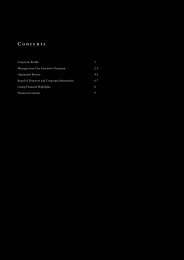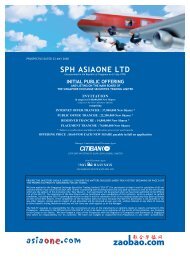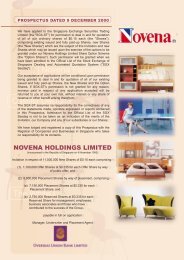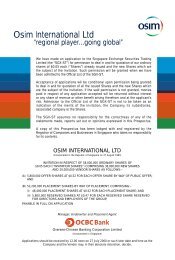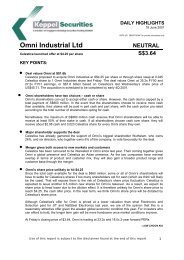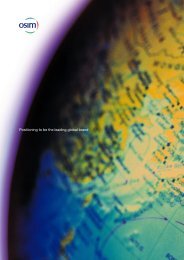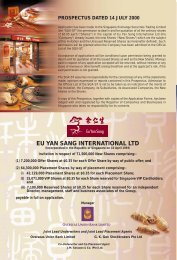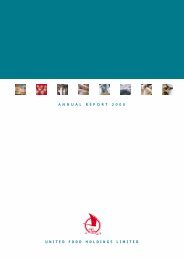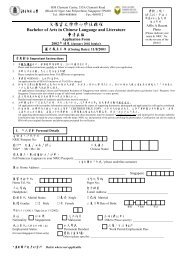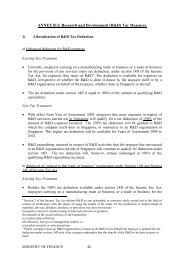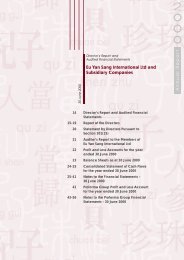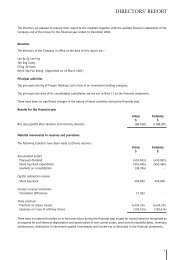final output
final output
final output
Create successful ePaper yourself
Turn your PDF publications into a flip-book with our unique Google optimized e-Paper software.
Prior to 1 April 1998, we recognised revenue upon completion of 25% of the estimated cost to<br />
completion for the project (“Completion”). However, with effect from 1 April 1998, we increased the<br />
revenue recognition threshold to 50% of Completion. Our management is of the view that as the size<br />
and number of projects increased, the unanticipated costs to completion can be more accurately<br />
estimated at the 50% stage of Completion. By increasing the threshold of revenue recognition, our<br />
management believes that it would better reflect the matching of our project revenues and costs, so<br />
as to have a better assessment of our project profits earned. The impact of the change in recognition<br />
threshold is set out on page 42 of this Prospectus.<br />
The value of our contracts would have taken into consideration our estimated cost to completion of<br />
the project and our anticipated profits which would in turn depend on several factors such as the<br />
complexity of the project, the level of skills required, the types of materials used and the estimated<br />
total man hours for completion.<br />
The key factors that affect our revenue include:-<br />
(a) State of economy in the Singapore Construction Industry<br />
Our turnover is dependent on the performance of the construction industry in Singapore. Fewer<br />
projects would be available following a contraction in the Singapore construction industry. At<br />
such times, contract values may be lower due to increased competition among main contractors<br />
and subcontractors such as ourselves due to the lack of supply of new projects. Ongoing<br />
projects may extend their dates of completion as developers maximise their cash flows and<br />
delay the sale of their residential units. To date, we have not experienced any major extension<br />
of completion dates in our projects by the developers or main contractors except as discussed<br />
on page 48 of this Prospectus. Such delays would result in a delay in recognition of our project<br />
revenue.<br />
(b) Number of invited tenders and awarded<br />
All our projects are awarded based on the invited tender basis. Main contractors competing for<br />
new projects may invite us to provide quotations on the M&E works of the project. After the<br />
main contractor is awarded the project, we may be invited to negotiate for the M&E contract<br />
sum with the main contractor. Our business volume depends on the number of invited tenders<br />
we receive and our ability to secure these projects.<br />
The number of invited tenders we receive depends on the number of referrals we receive from<br />
our customers or independent M&E consultants. In addition, our track record and past business<br />
dealings with existing customers would also affect the number of invited tenders we receive.<br />
Our Costs<br />
Our costs can be categorised into cost of sales and general and administrative expenses. Our costs<br />
of sales comprise mainly of labour costs, construction materials costs and depreciation costs of<br />
construction equipment and mobile toilets. General and administrative expenses comprise salaries<br />
and related expenses and depreciation on furniture, leasehold buildings and properties.<br />
Cost of Sales<br />
Our M&E cost of sales is predominantly labour costs and construction materials costs that in aggregate<br />
contribute to 97% of our M&E cost of sales for the last three financial years. The remaining 3% of<br />
our M&E cost of sales comprise of depreciation on construction machinery and transportation costs.<br />
As M&E installation is labour intensive, we require a large workforce of skilled and unskilled foreign<br />
workers. To ensure that the quality of work performed by these workers is consistent with our level<br />
of quality requirements, our project managers or site managers would visit each work site regularly<br />
to check on the progress and the quality of work. Labour costs accounts for 59.6% of our M&E cost<br />
of sales in the last three financial years. Our labour costs vary according to the complexity of the<br />
project. If a project requires high installation skills or requires more man hours for installation, our<br />
labour costs would increase.<br />
46



